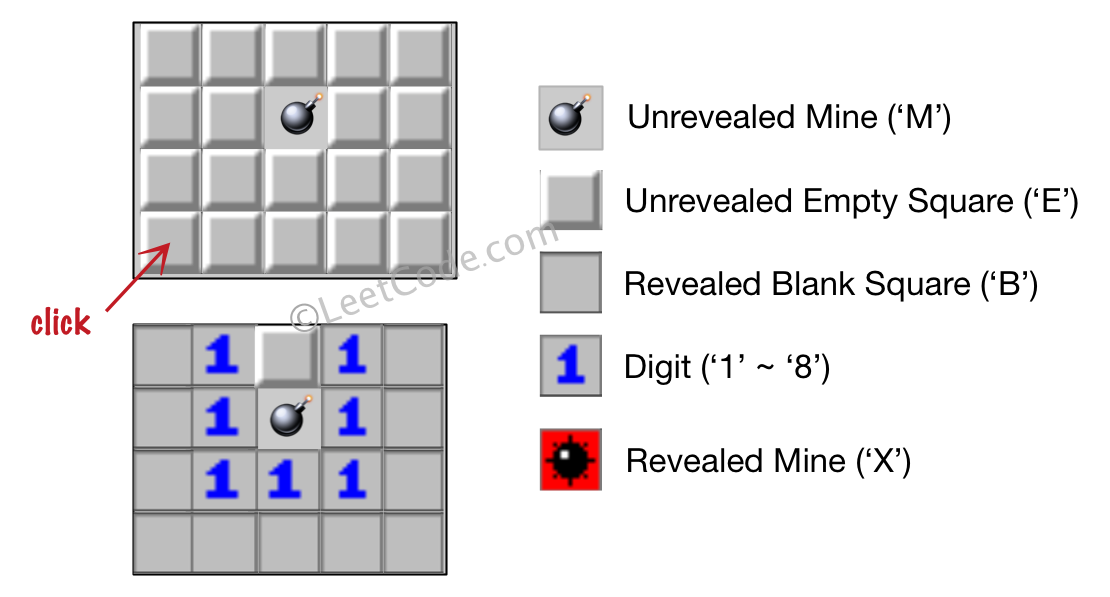Minesweeper
Let's play the minesweeper game (Wikipedia, online game)!
You are given an m x n char matrix board representing the game board where:
'M'represents an unrevealed mine,'E'represents an unrevealed empty square,'B'represents a revealed blank square that has no adjacent mines (i.e., above, below, left, right, and all 4 diagonals),- digit (
'1'to'8') represents how many mines are adjacent to this revealed square, and 'X'represents a revealed mine.
You are also given an integer array click where click = [clickr, clickc] represents the next click position among all the unrevealed squares ('M' or 'E').
Return the board after revealing this position according to the following rules:
- If a mine
'M'is revealed, then the game is over. You should change it to'X'. - If an empty square
'E'with no adjacent mines is revealed, then change it to a revealed blank'B'and all of its adjacent unrevealed squares should be revealed recursively. - If an empty square
'E'with at least one adjacent mine is revealed, then change it to a digit ('1'to'8') representing the number of adjacent mines. - Return the board when no more squares will be revealed.
Example 1:

Input: board = [["E","E","E","E","E"],["E","E","M","E","E"],["E","E","E","E","E"],["E","E","E","E","E"]], click = [3,0]
Output: [["B","1","E","1","B"],["B","1","M","1","B"],["B","1","1","1","B"],["B","B","B","B","B"]]
Example 2:

Input: board = [["B","1","E","1","B"],["B","1","M","1","B"],["B","1","1","1","B"],["B","B","B","B","B"]], click = [1,2]
Output: [["B","1","E","1","B"],["B","1","X","1","B"],["B","1","1","1","B"],["B","B","B","B","B"]]
Constraints:
m == board.lengthn == board[i].length1 <= m, n <= 50board[i][j]is either'M','E','B', or a digit from'1'to'8'.click.length == 20 <= clickr < m0 <= clickc < nboard[clickr][clickc]is either'M'or'E'.
Solution
There are a few things we need to keep in mind when implementing the problem:
- blank squares (
'B') and digit squares ('1'-'8') should be treated differently - a blank square's neighbours need to be revealed recursively
- only recursively reveal empty squares ('E')
We are given the click coordinate to update the board. If click is a mine ('M'), then we change it to 'X'.
If it's an empty square, then the update function updates the empty square recursively.
Implementation
def updateBoard(board: List[List[str]], click: List[int]) -> List[List[str]]:
if board == []: return []
row = len(board)
col = len(board[0])
def isbomb(i, j):
if i < 0 or j < 0 or i >= row or j >= col:
return False
elif board[i][j] == 'M' or board[i][j] == 'X':
return True
else: return False
def update(r, c):
if r < 0 or c < 0 or r >= row or c >= col: return
if board[r][c] == 'E': # empty square
bombs = 0 # number of neighbouring bombs
for i in range(r-1, r+2):
for j in range(c-1, c+2):
if isbomb(i, j): bombs += 1
if bombs: # update cell with number of bombs
board[r][c] = chr(48 + bombs)
else: # blank cell (0 bombs)
board[r][c] = 'B'
for i in range(r-1, r+2): # update neighbours
for j in range(c-1, c+2):
update(i, j)
# else already revealed, do nothing
r, c = click[0], click[1]
if board[r][c] == 'M': # bomb
board[r][c] = 'X'
else: # empty square, or revealed square
update(r, c)
return board
Ready to land your dream job?
Unlock your dream job with a 5-minute evaluator for a personalized learning plan!
Start EvaluatorGiven a sorted array of integers and an integer called target, find the element that
equals to the target and return its index. Select the correct code that fills the
___ in the given code snippet.
1def binary_search(arr, target):
2 left, right = 0, len(arr) - 1
3 while left ___ right:
4 mid = (left + right) // 2
5 if arr[mid] == target:
6 return mid
7 if arr[mid] < target:
8 ___ = mid + 1
9 else:
10 ___ = mid - 1
11 return -1
121public static int binarySearch(int[] arr, int target) {
2 int left = 0;
3 int right = arr.length - 1;
4
5 while (left ___ right) {
6 int mid = left + (right - left) / 2;
7 if (arr[mid] == target) return mid;
8 if (arr[mid] < target) {
9 ___ = mid + 1;
10 } else {
11 ___ = mid - 1;
12 }
13 }
14 return -1;
15}
161function binarySearch(arr, target) {
2 let left = 0;
3 let right = arr.length - 1;
4
5 while (left ___ right) {
6 let mid = left + Math.trunc((right - left) / 2);
7 if (arr[mid] == target) return mid;
8 if (arr[mid] < target) {
9 ___ = mid + 1;
10 } else {
11 ___ = mid - 1;
12 }
13 }
14 return -1;
15}
16Recommended Readings
Coding Interview Patterns Your Personal Dijkstra's Algorithm to Landing Your Dream Job The goal of AlgoMonster is to help you get a job in the shortest amount of time possible in a data driven way We compiled datasets of tech interview problems and broke them down by patterns This way
Recursion If you prefer videos here's a video that explains recursion in a fun and easy way Recursion is one of the most important concepts in computer science Simply speaking recursion is the process of a function calling itself Using a real life analogy imagine a scenario where you invite your friends to lunch https assets algo monster recursion jpg You first call Ben and ask him
Runtime Overview When learning about algorithms and data structures you'll frequently encounter the term time complexity This concept is fundamental in computer science and offers insights into how long an algorithm takes to complete given a certain input size What is Time Complexity Time complexity represents the amount of time
Want a Structured Path to Master System Design Too? Don’t Miss This!
